Saggy Gynecomastia
Up until now, we have discussed different types of gynecomastia based on the cause of the breast enlargement. Saggy Gynecomastia introduces a new problem – Excess Skin. When excess skin is present, the areola and nipple drops downward and sits on the lower part of the chest.
- Overview of Gynecomastia
- Causes of Gynecomastia
- Ideal male chest
- Joseph T Cruise, MD's Gynecomastia Philosophy
- 7 Types of Gynecomastia
- 1-Puffy nipple. Breast tissue outside of areola
- 2-Chest angle less than 45 °
- 3-Chest angle 45-60° Mild breast sag
- 4-Chest angle 60-90° Moderate breast sag
- 5-Chest angle greater than 90° Significant sag
- 6-Top of areola is above chest fold. Severe sag
- 7-Top of areola is below chest fold. Extreme sag
- Are You a Good Candidate?
- Benefits of Male Breast Reduction
- Components of Gynecomastia
- Classic Gynecomastia
- Puffy Nipples
- Fatty Gyecomastia
- Saggy Gynecomastia
- Breast Roll
- Prior to Male Breast Reduction
- Male Breast Reduction Anesthesia
- After the Male Breast Reduction
- Recovery from Male Breast Reduction
- Possible Complications
- Gynecomastia Cost and Financing
- Gynecomastia Words to Know
- Gynecomastia Before and After Pictures
Remember, there are 3 main causes of gynecomastia:
- Excess breast tissue
- Excess fat
- Excess skin
Excess skin introduces a higher level of complexity because the treatment requires skin removal. Removing the excess skin in this area involves making a donut shaped incision around the entire areola. Through this incision, the surgeon removes excess skin from above and often below the areola. This procedure not only raises the nipple/areola but it also tightens the skin. See the example of a donut lift below.
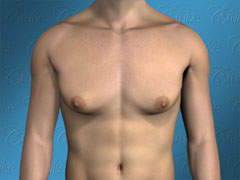 |
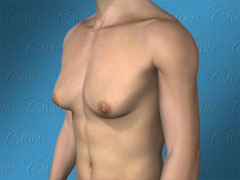 |
| Mild Saggy Gynecomastia – Notice the nipples are no longer facing forward. They have dropped closer to the chest fold | |
Typically, the nipple is 4-6 cm above the chest fold. When Saggy Gynecomastia is present, the nipple drops down closer to the chest fold and may even go below it in severe cases. Mild to moderate cases of Saggy Gynecomastia are often seen as men age or where there is poor skin quality. Severe cases are usually associated with massive weight loss, especially with treatments such as gastric bypass or Lap Band surgery.
Three Types of Saggy Gynecomastia
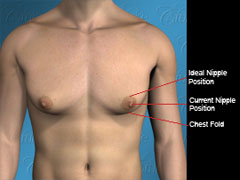 |
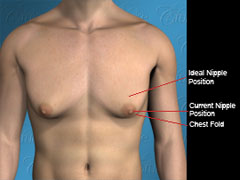 |
| Mild | Moderate |
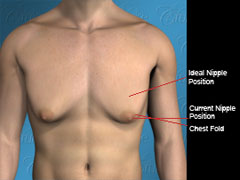 |
|
| Severe |
In the case of mild saggy gynecomastia, the nipples are approximately between 2-3 cm above the chest fold. In younger patients, the skin has the potential to snap back after the excess volume of the chest is removed. However, in older individuals, loss of skin elasticity can compromise its ability to recoil, and this snap back is not as likely. Skin quality is the main issue here.
Joseph T Cruise, MD prefers to not to perform the donut incision skin removal on younger patients with mild saggy gynecomastia as they often do not need it because their skin will recoil on its own. However, in older patients, a donut lift may be optimal depending on what the patient wants. The good news is that the incision from the donut lift is so small; it typically does not leave a scar that can be detected. By performing the donut lift, the nipple and areola is moved back into its ideal position and the skin is tightened, making the chest appear more youthful. Once again, this decision to have the donut lift is completely up to the patient.
Donut Lifts on the Three Types of Saggy Gynecomastia
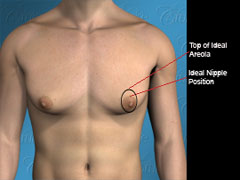 |
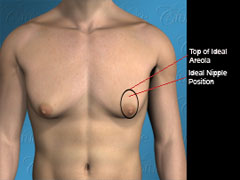 |
| Mild | Moderate |
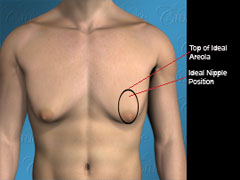 |
|
| Severe |
In moderate cases of saggy gynecomastia, nipples are located somewhere between the level of the chest fold and 2 cm above the chest fold. In severe cases of gynecomastia, nipples are below the chest fold. With moderate sagginess, a donut lift is usually necessary to place the nipple/areola in proper position and tighten the relaxed chest skin. The donut lift is like a purse string that circles around the incision. When tightened, the purse string suture draws the bigger circle into a smaller, elevated circle. This new smaller circle is in better position and has the correct diameter of the areola; then the areola is sutured in place.
Tightening of the purse string suture may cause some rippling, as the skin is compressed from a larger circle to a smaller circle. If rippling occurs it will subside within a few months and flatten out in most cases depending on what degree of sagginess is present. With mild sagginess, there will be little rippling but it will go away quickly. With moderate sagginess, there will be some rippling post operatively but it will also subside in time. With regard to scarring, the donut lift incisions fall directly within the margins of the darker colored areola, keeping these incisions well hidden.
Severe Gynecomastia may, or may not, be treatable with a donut lift alone. Such a large donut lift can leave persistent rippling, especially if the procedure is performed by a surgeon who does not perform gynecomastia surgery routinely. To avoid the potential for rippling in these cases, most plastic surgeons will approach the male breast lift much like a female breast lift and perform a full breast lift. However, this is not appropriate for types of gynecomastia, and a full breast lift leaves an anchor type incision that goes around the areola, down the chest to the chest fold, and then goes within the chest fold.
Joseph T Cruise, MD believes that these incisions are too obvious for male patients and typically does not perform this kind of lift. Instead, he performs as large of a donut lift as safely possible and aesthetically optimal based on his significant experience performing gynecomastia surgery. If excess skin is present 6 months post operatively, Joseph T Cruise, MD will perform only the horizontal incision and within the chest fold so there is no vertical scar down the chest. Remember, most patients do not have cases of severe saggy gynecomastia, as it is typically seen after massive weight loss.


